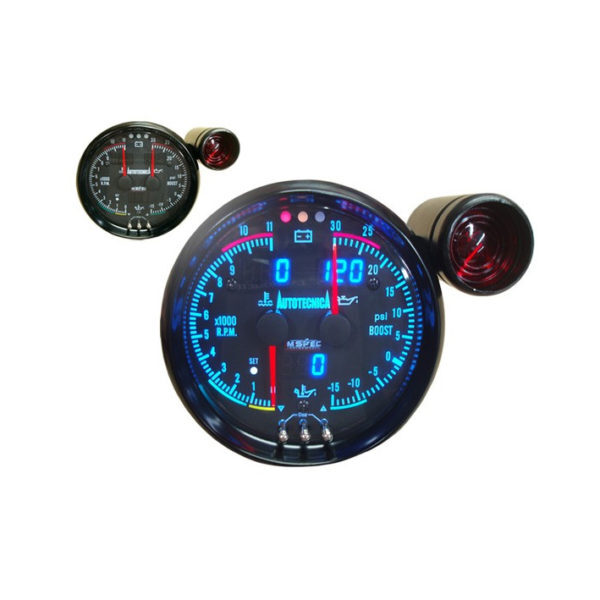Checking Out the Functions and Benefits of a Tachometer: A Comprehensive Guide for Automobile Fanatics
From supplying real-time data on engine speed to helping in optimizing equipment shifts, the tachometer offers as more than simply a dial on the control panel. Its multifaceted functions not just enhance driving experience but also play a pivotal function in preserving engine health and wellness and performance.
Understanding the Basics of a Tachometer
In the realm of vehicle instrumentation, recognizing the essentials of a tachometer is necessary for any type of automobile enthusiast looking to dive right into the details of engine efficiency surveillance. A tachometer, typically displayed on the control panel of a lorry, determines the engine's revolutions per min (RPM)
Tachometers typically have a range marked in transformations per minute, with a redline showing the maximum rate at which the engine can safely run (tachometer). This details is vital for protecting against engine damage and maximizing gear shifting for hands-on transmissions. Furthermore, tachometers can aid in detecting engine concerns such as misfires or a failing ignition system by identifying irregular RPM readings
Significance of Keeping Track Of Engine Rate

Keeping an eye on engine rate is an essential aspect of vehicle maintenance and efficiency optimization for automobile fanatics and specialists alike. The engine rate, measured in revolutions per min (RPM), suggests just how quick the engine's crankshaft is turning. By keeping a close eye on the RPM, motorists can make certain that the engine is running within the optimum variety, preventing possible damages from over-revving or delaying. Checking engine speed is specifically important throughout equipment changes, as it assists vehicle drivers establish the appropriate time to transform gears for smooth acceleration and efficient gas intake.
In addition, tracking engine rate can also give valuable insights into the overall wellness of the vehicle. On the whole, keeping track of engine speed with a tachometer is a basic technique that can enhance driving performance, prolong engine life, and ensure a more secure and much more satisfying driving experience.
Enhancing Performance With Gear Shifts
Appropriate gear shifting makes sure that the engine operates within its optimum power band, enabling for smooth acceleration and improved fuel economy. When shifting gears, it is critical to pay focus to the engine speed showed on the tachometer.

To attain peak performance via gear changes, vehicle drivers ought to exercise smooth and timely shifts in between equipments, matching engine speed with road rate to harness the full capacity of their lorry's powertrain.
Taking Full Advantage Of Efficiency With a Tachometer
Understanding the art of equipment changing in high-performance lorries see this page not only boosts driving experience however likewise plays a vital duty in maximizing performance with a tachometer. tachometer. By paying close interest to the tachometer analyses, vehicle drivers can optimize their gear changes to operate within the engine's most reliable variety. When speeding up, shifting equipments at the ideal RPM shown by the tachometer can avoid the engine from straining or underperforming, bring about improved fuel performance and total efficiency
Furthermore, a tachometer aids chauffeurs avoid unnecessary revving, which not just loses fuel but also places unnecessary strain on the engine. Continually keeping an eye on the tachometer while driving enables smoother gear shifts, lowering damage on the transmission system in time.

Advanced Tips for Tachometer Use
Enhancing driving precision through experienced tachometer analysis is essential to maximizing automobile performance. To delve right into advanced suggestions for tachometer usage, think about integrating using change lights. Shift lights are aesthetic signs that light up when it's time to move equipments based on engine transformations per minute (RPM), permitting for smooth equipment changes without constantly checking the tachometer. Furthermore, exercising heel-and-toe downshifting method can be helpful when aiming for smoother transitions between gears. This method includes utilizing both the brake and accelerator pedals concurrently while downshifting, aiding to preserve engine RPM and protect against jerky motions. Making use of an efficiency tachometer with personalized setups can supply real-time data tailored to certain driving preferences or vehicle alterations. By fine-tuning change points and establishing warning find out here limits, motorists can maximize acceleration and engine efficiency while lessening the danger of over-revving. These advanced techniques, when paired with a deep understanding of tachometer readings, can elevate driving effectiveness and total driving experience.
Final Thought
In verdict, the tachometer functions as a vital tool for auto enthusiasts to monitor engine speed, enhance efficiency through equipment changes, and maximize effectiveness. By understanding the functions and benefits of a tachometer, drivers can maximize their driving experience and prolong the life expectancy of their automobile. Utilizing innovative tips for tachometer usage can even more improve driving abilities and general performance on the roadway.